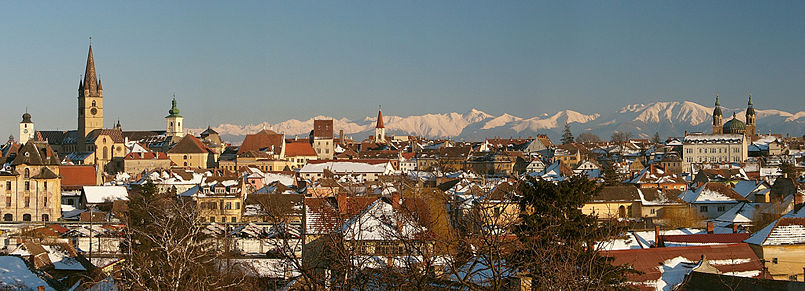Sibiu
| Sibiu Hermannstadt |
|||
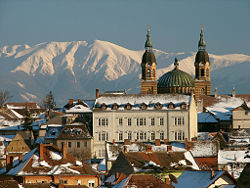 |
|||
|
|||
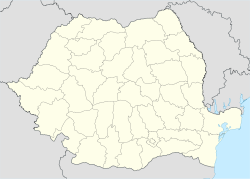 Sibiu
|
|||
| Coordinates: | |||
| Country | Romania | ||
|---|---|---|---|
| Sibiu County | Municipality of Sibiu | ||
| Founded | 1191 (first official record) | ||
| Government | |||
| - Mayor | Klaus Johannis (Democratic Forum of Germans) | ||
| Area | |||
| - Total | 121 km² (46.7 sq mi) | ||
| Elevation | 190 - 240 m (-597 ft) | ||
| Population | |||
| - Total | 154,458 | ||
| - Density | 1,273/km² (3,297.1/sq mi) | ||
| Time zone | EET (UTC+2) | ||
| - Summer (DST) | EEST (UTC+3) | ||
| Postal Code | 0xxxxx | ||
| Area code(s) | +40 269 | ||
| Car Plates | SB | ||
| Website: www.sibiu.ro | |||
Sibiu (IPA: [si'biw], German: Hermannstadt; Hungarian: Nagyszeben; Serbian: Сибињ/Sibinj; Yiddish: הערמאנשטאדט (Hermanshtadt) or סזעבען (Szeben), ) is one of the largest cities in Transylvania, Romania with a population of about 175,000. It straddles the Cibin River, a tributary of the river Olt. It is the capital of Sibiu County and is located some 282 km NW of Bucharest.
It is one of the most important cultural and religious centres in Romania as well a major transportation hub in central Romania. The city used to be the centre of the Transylvanian Saxons in Romania until World War II.
Sibiu was designated European Capital of Culture for the year 2007 together with Luxembourg.
Contents |
Geography and climate

Sibiu is situated near the geographical center of Romania at . Set in the Cibin Depression, the city is about 20 km from the Făgăraş Mountains, 12 km from the Cibin Mountains, and about 15 km from the Lotrului Mountains, which border the depression in its southwestern section. The northern and eastern limits of Sibiu are formed by the Târnavelor Plateau, which descends to the Cibin Valley through Guşteriţei Hill.
The Cibin river as well as some smaller streams runs through Sibiu. The geographical position of Sibiu makes it one of the most important transportation hubs in Romania with important roads and railway lines passing through it.
Sibiu's climate is temperate-continental with average temperatures of 8 to 9°C. The multi-annual average of rainfall is 662 l/mp, and there are about 120 days of hard frost annually.
History
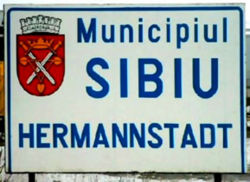
The city was founded in 1190 by German settlers. It was probably built near a Roman settlement, one that would be known during the early Middle Ages as Caedonia.
In the 14th century, it was already an important trade center. In 1376, the craftsmen were divided in 19 guilds. Sibiu became the most important ethnic German city among the seven cities that gave Transylvania its German name Siebenbürgen (literally seven cities), and it was home to the Universitas Saxorum, the assembly of Germans in Transylvania. Common opinion in the 17th century ascribed Sibiu the quality of being the easternmost city to be part of the European sphere; it was also the eastern terminus of postal routes.
During the 18th and 19th centuries, the city became the second and later the first most important center of Transylvanian Romanian ethnics. The first Romanian-owned bank had its headquarters here (The Albina Bank), as did the ASTRA (Transylvanian Association for Romanian Literature and Romanian's People Culture). After the Romanian Orthodox Church was granted status in the Habsburg Empire from the 1860s onwards, Sibiu became the Metropolitan seat, and the city is still regarded as the third most important center of the Romanian Orthodox Church. Between the 1848 Hungarian Revolution and 1867 (the year of the Ausgleich), Sibiu was the meeting-place of the Transylvanian Diet, which had taken its most representative form after the Empire agreed to extend voting rights in the region.
After World War I, when Austria-Hungary was dissolved, Sibiu became part of Romania; the majority of its population was still ethnic German (until 1941) and counted large Romanian and Hungarian communities. Starting from the 1950s and until after 1990, most of the city's ethnic Germans emigrated to Germany. Among the roughly 2,000 who have remained is Klaus Johannis, who is currently[update] mayor of Sibiu City.
Milestones in Sibiu's history
- 1191 - Mentioned for the first time in a document of the Vatican, under the name "Cibinium" (due to the river Cibin that flows through the city)
- 1292 - The first hospital in present-day Romania was opened.
- 1380 - The first documented school in present-day Romania.
- 1494 - The first pharmacy in present-day Romania.
- 1534 - The first paper mill in present-day Romania.
- 1544 - The first book in the Romanian language was printed in Sibiu.
- 1570 - Transylvania became an independent principality
- 1551 - Conrad Haas' experiment with rockets.
- 1671 - Methane gas was discovered near Sibiu.
- 1782 - Franz-Joseph Müller von Reichenstein discovered the chemical element tellurium.[1][2]
- 1788 - First theatre in present-day Romania.
- 1795 - The first lightning rod in Southeastern Europe was installed in Cisnădie.
- 1797 - Samuel Hahnemann opened the world's first homeopathic laboratory.
- 1817 - The Brukenthal Museum, the first museum in present-day Romania, was opened.
- 1867 - Union of Transylvania and Hungary
- 1896 - The first use of electricity in present-day Romania, and the first power line in Southeastern Europe.
- 1904 - The second city in Europe to use an electric-powered trolley.
- 1918 - Union of Transylvania and Romania. Sibiu became part of Romania
- 1928 - The first zoo in Romania.
- 1941 - Saxons lost their historical majority in the population
- 1989 - The third city to take part in the Romanian Revolution.
- 2007 - European Capital of Culture 2007
Cityscape
Population
As of approximately 2002[update], Sibiu has a population of about 160,000. The ethnic breakdown is as follows:
- Romanians 95%
- Hungarians 2%
- Germans 1.6%
- Other 1.4%
Population dynamics
- 1850: || 12.765 inhabitants
- 1900: |||| 21.465
- 1930: |||||||||| 49.345
- 1948: |||||||||||||| 60.602
- 1966: |||||||||||||||||||||| 109.515
- 1977: |||||||||||||||||||||||||||||| 151.005
- 1992: |||||||||||||||||||||||||||||||||| 169.610
- 2002: ||||||||||||||||||||||||||||||| 154.892
- 2007: ||||||||||||||||||||||||||||||||||| 175.000 (aprox.)
| Census[3] | Ethnical structure | |||
|---|---|---|---|---|
| Year | Population of Sibiu |
Romanians | Hungarians | Germans |
| 1850 | 12.765 | 2.089 | 977 | 8.790 |
| 1880 | 19.446 | 2.810 | 2.065 | 14.327 |
| 1890 | 21.465 | 4.581 | 3.199 | 13.148 |
| 1900 | 29.577 | 7.106 | 5.747 | 16.141 |
| 1910 | 33.489 | 8.824 | 7.252 | 16.832 |
| 1920 | 32.748 | 8.553 | 4.291 | 18.218 |
| 1930 | 49.345 | 19.006 | 6.782 | 22.045 |
| 1941 | 63.765 | 33.829 | 4.262 | 23.574 |
| 1948 | 60.602 | 37.371 | 5.060 | 16.359 |
| 1956 | 90.475 | 60.526 | 4.772 | 24.636 |
| 1966 | 109.515 | 78.548 | 5.124 | 25.387 |
| 1977 | 151.005 | 119.507 | 5.111 | 25.403 |
| 1992 | 169.610 | 158.863 | 4.163 | 5.605 |
Population by confession
Today, most of the population is of the Romanian Orthodox religion. Protestants and Roman Catholics represent about 5% of the population.
| Confessions in Sibiu | |||||||
| Confession | 1910 | 2002 | |||||
| Eastern Orthodox | 18 % | 91 % | |||||
| Greek-Catholic (Uniate) | 8 % | 1 % | |||||
| Roman-Catholic | 20 % | 2 % | |||||
| Evangelical Lutheran | 42 % | 2 % | |||||
| Reformed | 7 % | 1 % | |||||
| Jewish | 4 % | < 1 % | |||||
| Other | 1 % | 4 % | |||||
Politics

The mayor of Sibiu is Klaus Johannis, the president of the Democratic Forum of Germans in Romania (FDGR/DFDR). He was elected in 2000, being the first German mayor of a city in Romania since World War II. Johannis was overwhelmingly reelected in 2004 (with 88.7% of votes) and 2008 (with 83.26% of the votes cast) and his party gained an absolute majority in the city council. The German Forum also won the elections for mayor in the second and third most important towns in Sibiu county, Medias and Cisnadie, as well as one third (11 out of 33) of the seats in the county council.
This may seem surprising, as the Germans make up less than 2% of Sibiu's population and less than 3% of the county population, but the outcome is possibly due to popular perception of the territorial leaders of Romanian parties as being corrupt.
| Party | Seats in 2004 | Seats in 2008 | Current Council | ||||||||||||||
|---|---|---|---|---|---|---|---|---|---|---|---|---|---|---|---|---|---|
| Democratic Forum of Germans | 16 | 14 | |||||||||||||||
| Democratic Liberal Party | 2 | 4 | |||||||||||||||
| Social Democratic Party | 2 | 3 | |||||||||||||||
| National Liberal Party | 3 | 2 | |||||||||||||||
Prefecture and County Council
The leadership of the 2 county institutions based in Sibiu was elected in 2004:
- Prefect: Ilie Mitea (PNL)
- Viceprefect: Marin Crăciun (PNL)
- President of the County Council: Martin Bottesch (FDGR/DFDR)

City districts
The following districts are part of Sibiu. Some were villages annexed by the city but most were built as the city developed and increased its surface.
- Centru (Centre)
- Lupeni
- Trei Stejari (Three Oaks)
- Sub Arini (Under Alders)
- Vasile Aaron
- Hipodrom I, II, III, IV
- Valea Aurie (Golden Valley)
- Tilişca
- Ştrand I, II
- Turnişor (Little Tower)
- Piaţa Cluj (Cluj Plaza)
- Ţiglari
- Terezian
- Reşiţa
- Lazaret
- Guşteriţa
- Broscărie
Two main industrial areas are located within the city limits:
- Eastern industrial zone, alongside the railway to Braşov and Râmnicu Vâlcea
- Western industrial zone, near the exit to Sebes, close to the Airport
The Southern part, including the ASTRA National Museum Complex and the zoo, also falls inside the city limits.
Economy
Sibiu is one of the most prosperous cities of Romania, and also receives one of the highest rates of foreign investment in the country. It is an important manufacturer of automotive components (Bilstein-Compa, Takata, Continental, and SNR 'Ball bearing'). Other local industries are machine components, textiles, agro-industry, and electrical components (Siemens).
One of the main concerns for the city is attracting new investors to locate their businesses in Sibiu, and an industrial park has been recently completed. The city also contains Romania's largest stock exchange outside Bucharest, the Sibiu Stock Exchange.
Employment breakdown by economic sector
- Industry - 49%
- Commerce - 15%
- Construction - 7.5%
- Health - 7.5%
- Education - 7%
- Transport - 6.5%
Transport
Sibiu is well served in terms of transport and infrastructure, although the road traffic is congested because of the lack of a city bypass.
Air

Sibiu has an international airport with direct connections to Germany and Austria as well as to other Romanian cities. The airport is one of the most modern in Romania and the runway will be able to receive all types of commercial aircraft, including the Airbus A380, from 2008.
Direct flights from Sibiu:
- Munich (Lufthansa, Tarom)
- Vienna (Austrian Airlines)
- Bucharest, Târgu Mureş (Tarom)
- Timişoara (Carpatair)
- Stuttgart (Blue Air)
- Koln (Blue Air)
- Madrid (Blue Air)
Road
Sibiu is an important node in the European road network, being on two different European routes (E68 and E81). At a national level, Sibiu is located on three different main national roads, DN1, DN7 and DN14.
The Romanian Motorway A1 will link the city with Piteşti and the Romanian western border, near Arad. Funding for the project is assured and work is projected to be complete by 2014.
Sibiu is also an important hub for the international bus links with the biggest passenger transporter in Romania, Atlassib[4], based here. Transport companies are also providing coach connections from Sibiu to a large number of locations in Romania.
Rail
Sibiu is situated on the CFR-Romanian Railways Main Line 200 (Brasov - Făgăraş - Sibiu - Simeria - Arad - Romanian Western Border) and on Line 206 (Sibiu - Mediaş).
The city is served by three rail stations: the Main Station, the Little Station (Gara Micǎ) and Sibiu Turnişor. It has an important diesel-powered locomotives depot and a freight terminal.
Numerous InterCity trains (nicknamed Blue Arrows) connect Sibiu to other major cities in Romania: Cluj-Napoca, Braşov, Craiova, Timişoara and Bucharest.
Internal
Tursib[5] is the city's transport system and operates one tramway line to Răşinari, 5 trolleybus lines and about 25 bus lines.
Taxi companies are very strong in Sibiu with about 2000 taxis operating. The fares are the same for every company: 1.5 RON/km and 1 RON starting price. The city council regulations are very strict and impose the yellow colour for all taxis (as well as for all buses).
Tourism

In 2007, Sibiu was the European Capital of Culture (together with Luxembourg). It is the most important cultural event that has ever happened in the city and a great number of tourists are expected, both domestic and foreign. [6]
The city of Sibiu and its surroundings are one of the most visited areas in Romania. It holds one of the best preserved historical sites in the country, many of its medieval fortifications having been kept in excellent state. Its old center has begun the process for becoming a UNESCO World Heritage Site in 2004. Sibiu and its surrounding area have many significant museums, with 12 institutions housing art collections, paintings, and exhibits in decorative arts, archaeology, anthropology, history, industrial archeology and history of technology and natural sciences.
The city also lies close to the Făgăraş Mountains - a very popular trekking destination, close to the Păltiniş resort - a popular winter holiday destination, and it is at the heart of the former Saxon communities in Transylvania renowned for its fortified churches.
Accommodation

There are over 35 hotels in Sibiu, with different classifications. The most exquisite hotels are the Palace Resort & Spa 5*, located at the edge of the city, in the Dumbrava forest, Imparatul Romanilor 3*, Continental Forum 4* (former Bulevard), and Ramada 4*, located in the old medieval part of the city.
Other hotels are: Libra 4*, Parc 3*, Silva 3*, Casa Luxemburg 3*, Ana 3*, and many others.
There are also many pensions.
For backpackers you can find hostels as:
Old Town Hostel (Piata Mica)
Old John Wheeler Hostel (Mos Ion Roata street)
Joly Hostel (Filosofilor street)
Chess Hostel (Stefan cel Mare street)
Flying Time Hostel (Ghe. Lazar street)
Places of interest

Much of the city's aspect is due to its position, easily defensible, but allowing horizontal development. The old city of Sibiu lies on the right bank of the Cibin River, on a hill situated at about 200 m from the river. It consists of two distinct entities: the Upper Town and the Lower Town. Traditionally, the Upper Town was the wealthier part and commercial outlet, while the Lower Town served as the manufacturing area.
The Lower Town
The Lower Town (Romanian: Oraşul de jos) comprises the area between the river and the hill, and it developed around the earliest fortifications. The streets are long and quite wide for medieval city standards, with small city squares at places. The architecture is rather rustic: typically two-storey houses with tall roofs and gates opening passages to inner courts.
Most of the exterior fortifications were lost to industrial development and modern urban planning in the late 19th century; only one or two towers still exist. A building associated with newer urbanism of the period is the Independenţa Highschool.
This area has the oldest church in the city, dating back to 1292.
The Upper Town
The Upper Town (Romanian: Oraşul de sus) is organised around three city squares and a set of streets along the line of the hill. As the main area for burgher activities, the area contains most points of interest in Sibiu.
The Large Square

The Large Square (Romanian: Piaţa Mare, German: Großer Ring) is, as its name suggests, the largest square of the city, and has been the center of the city since the 16th century. 142 m long and 93 m wide, it is one of the largest ones in Transylvania.
Brukenthal Palace, one of the most important Baroque monuments in Romania, lies on the north-western corner of the square. It was erected between 1777 and 1787 as the main residence for the Governor of Transylvania Samuel von Brukenthal. It houses the main part of the National Brukenthal Museum, opened in 1817. Next to the palace is the Blue House, an 18th century Baroque house bearing the old coat of arms of Sibiu on its façade.

On the north side is the Jesuit Church, along with its dependencies, the former residence of the Jesuits in Sibiu. Also on the north side, at the beginning of the 20th century an Art Nouveau building was constructed on the west part, now it houses the mayor's office.
Next to the Jesuit Church on the north side is the Council Tower, one of the city's symbols. This former fortification tower from the 14th century has been successively rebuilt over the years. The building nearby used to be the City Council's meetingplace; beneath it lies an access way between the Large Square and the Small Square.
On the south and east sides are two- or three-storey houses, having tall attics with small windows known as the city's eyes. Most of these houses are dated 17th to 19th centuries, and most of them are Baroque in style.
The Small Square


As its name says, the Piaţă Mică is smaller in size, being rather longer than wide. Its north-west side has a curved shape, unlike the Large Square, which has an approximately rectangular shape. Accordingly, Piaţă Mică plays a smaller part in the city's present-day life.
The square is connected to the other two squares and to other streets by small, narrow passages. The main access from the Lower City is through Ocnei Street, which divides the square in two. The street passes under the Liar's Bridge - the first bridge in Romania to have been cast in iron (1859).
To the right of the bridge is another symbol of the city, The House of the Arts, an arched building formerly belonging to the Butchers' Guild. On the left side of the bridge is the Luxemburg House, a Baroque four-storey building, former seat of the Goldsmiths' Guild.
The Huet Square
Huet Square is the third of the three main squares of Sibiu. Its most notable feature is the Evangelical Lutheran Cathedral in its center. It is the place where the earliest fortifications have been built. The buildings around this square are mainly Gothic. On the west side lies the Brukenthal Highschool, in place of a former 14th century school.
The fortifications

The city of Sibiu was one of the most important fortified cities in Southeastern Europe. Multiple rings were built around the city, most of them out of clay bricks. The south-eastern fortifications are the best kept, and all three parallel lines are still visible. The first is an exterior earth mound, the second is a 10-meter-tall red brick wall, and the third line comprises towers linked by another 10-meter-tall wall. All structures are connected via a labyrinth of tunnels and passageways, designed to ensure transport between the city and lines of defense.
In the 16th century more modern elements were added to the fortifications, mainly leaf-shaped bastions. One of these survived to this day, as the Haller Bastion (all the way down Coposu Boulevard).
Passage of the Stairs
The steep Passage of the Stairs leads down to the lower section of Sibiu. It descends along some fortifications under the support arches. It is the most picturesque of the several passages linking the two sides of the city.
Culture

Sibiu is one of Romania's most culturally lively cities. It has two theatres and a philharmonic orchestra.
The Radu Stanca National Theatre [7] is one of the leading Romanian theatres. With origins dating back to 1787, it attracts some of the best-known Romanian directors, such as Tompa Gábor and Silviu Purcărete. It has both a Romanian-language and a German-language section, and presents an average of five shows a week.
The Gong Theatre is specialised in puppetry, mime and non-conventional shows for children and teenagers. It also presents shows in both Romanian and German.
The State Philharmonic of Sibiu [8] presents weekly classical music concerts, and educational concerts for children and teenagers. The concerts take place in the newly restored Thalia Hall, a concert and theatre hall dating from 1787, situated along the old city fortifications. Weekly organ concerts are organised at the Evangelical Cathedral during summers, and thematic concerts are presented by the Faculty of Theology choir at the Orthodox Cathedral.
Museums

Sibiu's museums are organised around two entities: the Brukenthal National Museum and the ASTRA National Museum Complex. The Brukenthal Museum consists of an Art Gallery and an Old Books Library located inside the Brukenthal Palace, a History Museum located in the old town hall building, a Pharmacy Museum located in one of the first apothecary shops in Europe, dating from the 16th century, a Natural History Museum and a Museum of Arms and Hunting Trophies.
The ASTRA National Museum Complex focuses on ethnography, and consists of a Traditional Folk Civilisation Museum—a 96-hectare open-air museum located on a forest south of Sibiu—a Universal Ethnography Museum, a Museum of Transylvanian Civilisation and a Museum of Saxon Ethnography and Folk Art. It also has a project of opening a Museum of the Culture and Civilisation of the Romany People.
There is a Steam Locomotives Museum close to the railway station, sheltering around 40 locomotives, two of which are functional.
Events
Several festivals are organised yearly in Sibiu, the most prestigious of them being the Theatre Festival, organized each spring at the end of May. The ArtMania rock festival is held every Summer since 2006 and as of 2008 the Rockin' Transilvania Festival is also held in Sibiu. The oldest Jazz Festival in Romania is organized here, as well as the "Carl Filtsch" festival for young classical piano players, the "Astra Film" documentary film festival, the Transylvania calling Festival a Multi Cultural 6 day Open Air Music festival! 26-31 July 2007, a medieval arts festival and many more smaller cultural events. [9]
European Cultural Capital
The designation as a European Cultural Co-Capital for 2007, owed greatly to the excellent collaboration with Luxembourg, but also to what many regard as a miraculous social rebirth taking place in the city during the last years.
The Cultural Capital status was expected to bring about an abrupt increase in quantity and quality of cultural events in 2007. The long term effects, on the other hand, and the impact on the city's inhabitants are quite disputed. Some people consider the status of Cultural Capital a natural recognition of the city's merits, while young intellectuals consider it less of a recognition and more of a chance that has been generously granted to Sibiu.[10]
Education


Sibiu is an important centre of higher education, with over 34,000 undergraduate students in 2007 (counting for almost one fourth of the entire population).
The Lucian Blaga University of Sibiu[11] was founded in 1990, with five faculties: Engineering and Sciences; Letters; History and Law; Medicine; Food and Textile Processing Technology. Nowadays, it has many departments.
- Andrei Şaguna Faculty of Theology
- Faculty of Letters and Arts
- Nicolae Lupu Faculty of History and Patrimony
- Simion Bărnuţiu Faculty of Law
- Hermann Oberth Faculty of Engineering[12]
- Faculty of Sciences
- Victor Papilian Faculty of Medicine
- Faculty of Economics
- Faculty of Journalism
- Faculty of Agricultural Sciences, Food Industry and Environmental Protection
- The University College
- Department for Distance and E-Learning[13]
Sibiu also houses the Nicolae Bălcescu Land Forces Military Academy, as well as some private universities.
In Sibiu there are 20 educational institutions on the secondary level, the most prestigious of which are:
- Gheorghe Lazăr National College - mainly sciences and informatics, with some bilingual classes
- Samuel von Brukenthal National College - German language high school
- Octavian Goga National College - social sciences, sciences and informatics
- Onisifor Ghibu Theoretical Highschool - informatics, social sciences and sports
- Andrei Şaguna National College - training for schoolteachers, informatics, social sciences and sports
- Constantin Noica Theoretical Highschool - social sciences and sciences
Sports teams
- Football (soccer)
- FC Sibiu
- Atletic Sibiu
- Rugby
- CSM Sibiu
- Volleyball
- CSM Sibiu (men)
- CSS Sibiu (women)
- Basketball
- CSU Atlassib Sibiu (men)
- Handball
- CSM Sibiu (women)
- CSM Sibiu (men)
Natives
- Arthur Arz von Straussenburg, Austro-Hungarian general
- Miklós Borsos, Hungarian sculptor
- Andrei Codrescu, American writer
- Sabina Cojocar, Romanian gymnast
- Sándor Domanovszky, Hungarian historian
- Mihaela Fera, Olympic skier
- Steve Holmes, German pornographic actor
- Iancu Sasul, Moldavian ruler
- Hermann Kusmanek von Burgneustädten, Austro-Hungarian general
- Hermann Oberth, German space flight technology pioneer
- Nicolaus Olahus, Hungarian archbishop
- Oskar Pastior, Romanian-German poet and translator
- Dan Perjovschi, Romanian artist
- Lia Perjovschi, Romanian artist
- János Márton Stock, Hungarian painter
- Tobias Stranovius, Saxon painter
- Viorel Tilea, Romanian diplomat
- Steliana Nistor, Romanian gymnast
Twinned towns
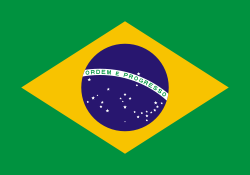 Bauru since 1995.
Bauru since 1995. Columbia, Missouri since 1994.
Columbia, Missouri since 1994. Deventer since 2007[14].
Deventer since 2007[14]. Klagenfurt since 1990.
Klagenfurt since 1990. Landshut since 2002.
Landshut since 2002. Marburg since 2005.
Marburg since 2005. Mechelen since 1996.
Mechelen since 1996. Rennes since 1999.
Rennes since 1999. Valencia, Venezuela since 1993.
Valencia, Venezuela since 1993. Wirral since 1994.
Wirral since 1994.
Legations
Currently there are two legations in Sibiu:
 General Consulate of the Federal Republic of Germany.
General Consulate of the Federal Republic of Germany.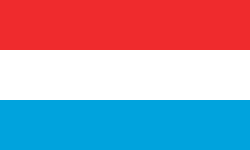 Honorary Consulate of the Grand Duchy of Luxembourg.
Honorary Consulate of the Grand Duchy of Luxembourg.
References
- Sibiu on RomaniaTourism.com. Reference regarding surface area, population, etc. Retrieved 22 November 2005.
- Sibiu Online - Official Site with information on tourism and history, Sibiu pictures, and more. In Romanian, English and German.
External links
- A short trip trough Sibiu - 360° interactive panoramic images
- Sibiu European Cultural Capital 2007 - Official Site
- Samuel von Brukenthal Foundation; about the summer residence of Baron Samuel von Brukenthal in Sibiu
- "Nicolae Bălcescu" Land Forces Academy - Official Site
- Romanian Scouts - "Heintz Dezideriu" Subsidiary - Sibiu
- Sibiu travel guide from Wikitravel
- Article on Sibiu as Capital of Culture in Bucharest's The Diplomat
- Sibiu Photo Gallery
- Sibiu Photo Gallery
- Romania in images - Sibiu City
- Photos from Sibiu
- (Romanian)The European Cultural Capital Debate
- Restoration of Historical Monuments in Sibiu - Report and Photo Gallery
- - Borders of Sibiu (Marginimea Sibiului)
- Sibiu 2007- Jethro Tull in concert
- Sibiu Live - Live Images from Sibiu
Notes
- ↑ "Periodic Table: Date of Discovery". Retrieved on 2007-03-13.
- ↑ "Timeline of Element Discovery". Retrieved on 2007-03-13.
- ↑ Varga E. Árpád: Statistici etnice şi confesionale pentru Transilvania
- ↑ Atlassib - Official Site
- ↑ Tursib - Official Site
- ↑ Sibiu - European Capital of Culture - Official Site
- ↑ Radu Stanca National Theatre - Official Site
- ↑ State Philharmonic of Sibiu - Official Site
- ↑ 2006 Cultural Programme
- ↑ R. Al. Nica: Mirajul schimbării la faţă a Sibiului (Interviu) - Sibiu
- ↑ Lucian Blaga University of Sibiu - Official Site
- ↑ Hermann Oberth Faculty of Engineering - Official Site
- ↑ Department for Distance and E-Learning - Official Site
- ↑ (Romanian)Sibiu Town Hall Official Site, Acordul de infratire intre Sibiu si orasul Deventer din Olanda, 23 may, 2007
 |
Sebeş | Mediaş Ocna Sibiului |
Agnita |
|
|||
| Sălişte | Avrig | ||||||
| Răşinari | Cisnădie | Tălmaciu |
|
|||||
|
|||||||||||||
|
|||||||
